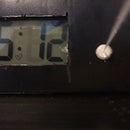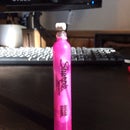Introduction: Edge Lit Arc Reactor
I've seen lots of really cool edge lit displays. There are lots of instructables on them but this one is mostly just to show how I made mine. It's not that great, it was my first time attempting to etch the acrylic. It turned out a bit patchy and didn't catch the light as I'd hoped it would. I'm planning to make another, better, one later on. But this is going to be a quick tutorial on how I made this arc reactor edge lit display.
Materials:
- Clear blue LEDs (3)
- 330 ohm resistors (3)
- Acrylic sheet (1/4")
- Cardboard
- 9V Battery (1)
- 9V Battery snap
- Piece of perf board
- Spare wire
Tools:
- Dremel
- Sphere tipped bit
- Cutting drill bit
- Hot Glue gun
- Soldering Iron
Materials:
- Clear blue LEDs (3)
- 330 ohm resistors (3)
- Acrylic sheet (1/4")
- Cardboard
- 9V Battery (1)
- 9V Battery snap
- Piece of perf board
- Spare wire
Tools:
- Dremel
- Sphere tipped bit
- Cutting drill bit
- Hot Glue gun
- Soldering Iron
Step 1: Setting Up the Acrylic
First of all you'll have to pick a design. If you want to use an arc reactor I just found the image online searching for arc reactor stencils. Once you choose a design, put it into a word processor and measure the sides, to get it the size you want. Then print it.
Next you're going to need to get the piece of acrylic. Place it over the image to determine what size you are gonna need. You will probably want to leave an extra inch or so at the bottom (that way the LEDs are hidden from view). Once you have figured out the general size, take a rule and draw a straight line (along which you will cut later). I would recommend using expo marker so that it isn't a permanent mark on the acrylic.
Once you have it all measured, get ready to cut it. Take the piece of acrylic and clamp it down tight to your workbench. Make sure to leave it off the edge a little so you don't cut into the table. Take the Dremel bit and drill a small hole right in the corner, the inner corner, then take it and continue to put force on the Dremel. Following the lines that you drew until it is completely cut. Make sure that you hold on to the cut piece though! You don't want any unnecessary scratches.
Next you're going to need to get the piece of acrylic. Place it over the image to determine what size you are gonna need. You will probably want to leave an extra inch or so at the bottom (that way the LEDs are hidden from view). Once you have figured out the general size, take a rule and draw a straight line (along which you will cut later). I would recommend using expo marker so that it isn't a permanent mark on the acrylic.
Once you have it all measured, get ready to cut it. Take the piece of acrylic and clamp it down tight to your workbench. Make sure to leave it off the edge a little so you don't cut into the table. Take the Dremel bit and drill a small hole right in the corner, the inner corner, then take it and continue to put force on the Dremel. Following the lines that you drew until it is completely cut. Make sure that you hold on to the cut piece though! You don't want any unnecessary scratches.
Step 2: Begin the Etching
To start the etching process you're going to need your printed stencil. What I did was place the stencil underneath the acrylic. I did this because the acrylic is see-through so it would be easier for me to see it without having to cut out the stencil (I also tried tracing over the outline of the stencil with expo marker, but I wouldn't recommend this. It just gets in the way).
Once you get the paper lined up with the acrylic, clamp both down tightly to your workbench, making sure the paper is on the bottom. Then you're going to take the "spherical" tipped Dremel bit and spin it at a manageable speed, I set mine at about 12. Then take the Dremel along the whole outline of the stencil. Once you've outlined it, start to fill it in. While filling it in its a good idea to make quick motions. I went slow and made lots of little pits and mistakes in the acrylic.
Once the whole shape is filled in, you can unclamp it and the acrylic piece is done!
Once you get the paper lined up with the acrylic, clamp both down tightly to your workbench, making sure the paper is on the bottom. Then you're going to take the "spherical" tipped Dremel bit and spin it at a manageable speed, I set mine at about 12. Then take the Dremel along the whole outline of the stencil. Once you've outlined it, start to fill it in. While filling it in its a good idea to make quick motions. I went slow and made lots of little pits and mistakes in the acrylic.
Once the whole shape is filled in, you can unclamp it and the acrylic piece is done!
Step 3: Setting Up the Lighting
Once the acrylic is all etched, the last thing is to wire up the LEDs. If you happen to have a nice strip of LEDs that'd be best as you can just glue them down and plug them in. However, as I did not have a strip like that, I just took some LEDs and wired them up by hand (which is more fun to me anyways (: ).
First off, take the LEDs and wire the positive end (the longer lead) to a resistor. The resistors aren't polarized so it doesn't matter how you connect them. You'll want to make sure to solder the leads so they stay together. Next you'll need to solder pieces of wire to the ends of the resistors and the GND lead of the LEDs. Make sure that you aren't wiring the LEDs together yet! And make sure you solder the connections.
Next, take the perf board and solder the. 9V snap to one end. Then wire the resistor leads, in parallel, to the positive end of the battery snap. Make sure all are soldered to the perf board. Then take all the GND wires and solder them to the GND side of the battery snap.
Once that's done test them out. If the LEDs all light up and don't burn out you did it right! I burned out an LED or two just testing the acrylic. All that's left now is to glue the LEDs to the acrylic.
To do this take one edge, the bottom of your display, and glue each LED a few inches apart from each other. With the hot glue you will probably have to hold them on for a minute or two before the glue dries. After this you can take the two pieces of cardboard strips and cut them to the desired width and height. Then glue one to the backside of the LEDs and the acrylic piece. Next, glue down the leads of each LED to this bottom piece of cardboard. Make sure that you don't let any of the wired touch or they will short! After this is done and all the leads are glued you can glue the next piece of cardboard on the other side. Then glue the perf board to the back. And your all done! Connect the battery and the acrylic edges as well as the etched area should all light up bright!
First off, take the LEDs and wire the positive end (the longer lead) to a resistor. The resistors aren't polarized so it doesn't matter how you connect them. You'll want to make sure to solder the leads so they stay together. Next you'll need to solder pieces of wire to the ends of the resistors and the GND lead of the LEDs. Make sure that you aren't wiring the LEDs together yet! And make sure you solder the connections.
Next, take the perf board and solder the. 9V snap to one end. Then wire the resistor leads, in parallel, to the positive end of the battery snap. Make sure all are soldered to the perf board. Then take all the GND wires and solder them to the GND side of the battery snap.
Once that's done test them out. If the LEDs all light up and don't burn out you did it right! I burned out an LED or two just testing the acrylic. All that's left now is to glue the LEDs to the acrylic.
To do this take one edge, the bottom of your display, and glue each LED a few inches apart from each other. With the hot glue you will probably have to hold them on for a minute or two before the glue dries. After this you can take the two pieces of cardboard strips and cut them to the desired width and height. Then glue one to the backside of the LEDs and the acrylic piece. Next, glue down the leads of each LED to this bottom piece of cardboard. Make sure that you don't let any of the wired touch or they will short! After this is done and all the leads are glued you can glue the next piece of cardboard on the other side. Then glue the perf board to the back. And your all done! Connect the battery and the acrylic edges as well as the etched area should all light up bright!




